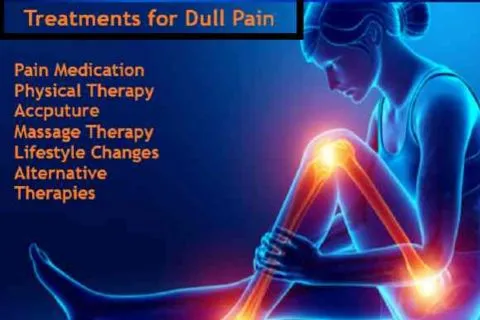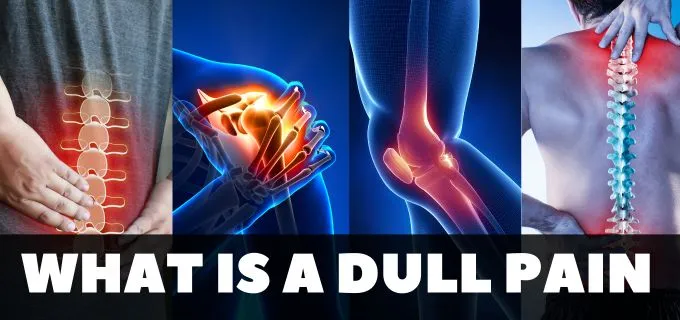Pain is an unpleasant sensation that can be felt in different parts of the body, and it can be either acute or chronic. Acute pain is usually short-lived and is caused by a specific injury or illness, while chronic pain can last for weeks, months, or even years, and can be caused by a variety of underlying conditions.
What is a Dull Pain?
Dull pain is a type of chronic pain that is characterized by a persistent, low-grade ache that is often described as a dull, throbbing sensation. Unlike sharp or intense pain, which is usually a sign of tissue damage or inflammation, dull pain is often more diffuse and difficult to localize. Several things, such as accidents, illnesses, and chronic disorders, might contribute to it.
We’ll talk about the origins, signs, and treatments of dull pain and What is a Dull Pain? in this blog post, as well as how it could interfere with your regular activities.
A common kind of chronic pain that can significantly affect a person’s daily life is dull pain. Although there exist therapies, it is essential to prioritize prevention and management. Having good posture, taking pauses, wearing the right shoes, and leading a healthy lifestyle can all help lower the likelihood of experiencing some types of dull pain. Individuals can manage their discomfort and enhance their general well-being by getting medical assistance, working with mental health providers, and learning coping mechanisms. Pain is a distressing feeling often caused by intense or damaging stimuli.
What is sharp vs dull pain?
Sharp pain is commonly linked with acute injuries or conditions like cuts or broken bones. Nonetheless, it can also signify potential underlying health problems such as appendicitis or kidney stones.. Conversely, dull pain is often described as a more widespread and challenging to locate sensation that may cause throbbing or aching.
| Sharp Pain | Dull Pain | |
| Description | Acute, intense pain | Throbbing or aching sensation |
| Intensity | Severe | Mild to moderate |
| Duration | Short-lived | Persistent |
| Causes | Acute injuries or conditions, like cuts or broken bones | Chronic conditions, like arthritis or fibromyalgia |
| Location | Localized and easier to pinpoint | Widespread and difficult to pinpoint |
| Symptoms | May indicate serious underlying conditions,like appendicitis or kidney stones | May indicate chronic underlying conditions, like neuropathy or cancer |
| Treatment | Depends on the underlying cause and may include medication, surgery, or other therapies. | Depends on the underlying cause and may include medication, lifestyle changes, or other therapies. |

Causes of Dull Pain:
There are numerous underlying diseases that can result in dull pain, including:
Chronic Conditions:
Chronic, low-grade pain that is frequently described as dull or achy can be brought on by diseases like fibromyalgia, arthritis, and chronic fatigue syndrome.
Nerve Damage:
Dull pain that is frequently accompanied by numbness or tingling feelings can be caused by neuropathy or nerve injury.
Injuries:
Injuries such as sprains, strains, and fractures can cause dull pain that persists even after the initial injury has healed.
Inflammation:
Chronic inflammation in the body can cause dull pain that is often accompanied by stiffness or swelling.
Postural Problems:
Poor posture or repetitive strain injuries can cause dull pain in the neck, back, and shoulders.
Symptoms of Dull Pain:
Depending on the underlying reason, other symptoms of dull pain may also include stiffness or discomfort in the affected area, weariness, trouble falling asleep, and reduced range of motion. Diffuse pain occasionally coexists with additional symptoms like redness, swelling, or inflammation.
Some common symptoms include:
- A persistent, low-grade ache that is often described as dull or throbbing.
- Pain that is diffuse and difficult to localize.
- Stiffness or swelling in the affected area.
- Numbness or tingling sensations.
- Reduced range of motion in the affected joint or muscle.
- Fatigue or difficulty sleeping.
- Depression or anxiety.
Effects of Dull Pain on Daily Life:-
Dull pain can have a significant impact on your daily life, as it can make it difficult to perform even simple tasks such as walking, standing, or sitting for prolonged periods. It can also interfere with your ability to work or enjoy recreational activities, and it can affect your sleep, mood, and overall quality of life.
Together with physical symptoms like weariness and decreased mobility, chronic pain is frequently linked to psychological problems including depression, anxiety, and other conditions.This can create a vicious cycle in which pain exacerbates psychological symptoms, and psychological symptoms in turn exacerbate pain.
Treatments for Dull Pain:-
The underlying reason will determine how to treat dull pain. Medication such as painkillers, anti-inflammatory meds, or antidepressants may be used as a therapy option if the pain is brought on by a chronic illness like arthritis or fibromyalgia. To help control the discomfort, physical therapy, physical activity, and relaxation methods like yoga or meditation may also be suggested.
Modifying one’s lifestyle might also help manage dull pain. Inflammation and discomfort can be reduced and eased with a nutritious diet, frequent exercise, and adequate rest. Also, avoiding pain-worsening triggers like specific meals and activities might assist increase general comfort.
Depending on the underlying illness producing the dull pain, there are numerous therapies available. Typical treatments include:
Pain Medications:
Mild to moderate pain can be relieved with over-the-counter pain medications like ibuprofen or acetaminophen, while prescription pain medications may be required for severe pain.
Physical Therapy:
Physical therapy can help with mobility issues, pain management, and injury prevention..
Acupuncture:
It has been demonstrated that acupuncture is beneficial in treating chronic pain, especially dull pain.
Massage Therapy:
By reducing muscle tension and improving circulation, massage therapy can alleviate pain and stiffness. Additionally, it promotes relaxation and increases blood flow to the affected area, all of which can help alleviate pain. There are several different massage techniques that may be effective for managing dull pain, including, Muscle Rub Peppermint, Muscle Rub Fire Cream
Lifestyle Changes:
Making lifestyle changes such as improving posture, reducing stress, and maintaining a healthy diet and exercise routine can help
Alternative Therapies
Some alternative therapies such as yoga, meditation, and mindfulness practices can also help individuals manage their pain and improve their overall well-being.

Preventing Dull Pain:-
Your regular life may be hampered by dull discomfort, which can make it difficult to concentrate on your work or take pleasure in your favorite activities. Thankfully, there are measures you can take to halt and decrease dull pain.
One of the most crucial techniques to stop dull discomfort is to keep a decent posture. Poor posture can result in unnecessary tension in your muscles and joints, leading to discomfort and pain. Maintaining a neutral spine and keeping your shoulders down while sitting or standing up straight can alleviate this. Decrease the amount of time you spend standing or sitting in one place, and take pauses to stretch and move about.
Keeping a healthy weight is a crucial part of preventing dull ache. The pressure that extra weight can place on your joints, especially the ones in your back, hips, and knees, can cause pain and discomfort. Eating a healthy, balanced diet and getting regular exercise can help you maintain a healthy weight and reduce your risk of developing chronic pain.
Dull discomfort can also be caused by stress. Your body creates hormones during times of stress that may worsen pain and inflammation. Relaxation practices such as deep breathing, meditation, and yoga can aid in reducing stress and easing discomfort.
Last but not least, be sure to get enough sleep. In addition to aggravating pain, sleep deprivation can lead to additional health issues. To help you fall asleep and stay asleep, set a consistent sleep schedule and aim for 7-8 hours of sleep each night.
FAQS
There are many different types of pain.but the main are four
Acute Pain.
Chronic Pain.
Neuropathic Pain.
Nociceptive Pain.
The term “dull pain” is frequently used to describe prolonged or chronic discomfort. Although you feel a sharp pain in the affected location, it usually doesn’t interfere with your everyday activities. Simple headaches are one example of dull pain.
Even though it might be challenging to categorize and comprehend the many different pathways behind pain, many pain syndromes are common. Some of the most frequent causes of pain among patients are arthritis pain, low back pain, headaches, post-operative pain, cancer pain, and headaches.
Conclusion:-
In conclusion, dull pain is a typical form of chronic pain that can significantly affect a person’s day-to-day activities. Although therapies exist, prevention and management are crucial.. Having good posture, taking pauses, wearing the right shoes, and leading a healthy lifestyle can all help lower the likelihood of experiencing some types of dull pain. Individuals can manage their discomfort and enhance their general well-being by getting medical assistance, working with mental health providers, and learning coping mechanisms.
Also, it’s crucial to remember that while medications and other treatments can aid in managing dull pain, they could not entirely eradicate it. As a result, it’s critical that people come up with coping mechanisms and adopt a positive attitude on life. This may entail engaging in fun hobbies, practising mindfulness, and asking loved ones for help.
